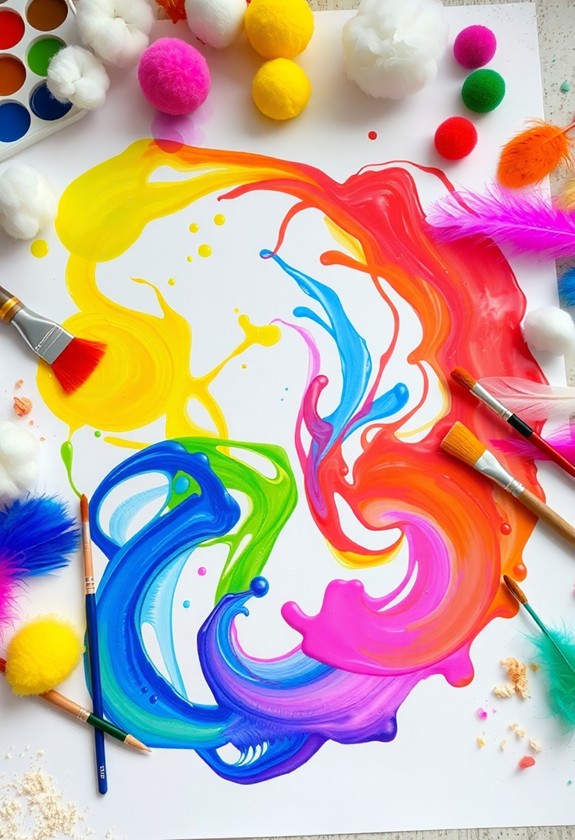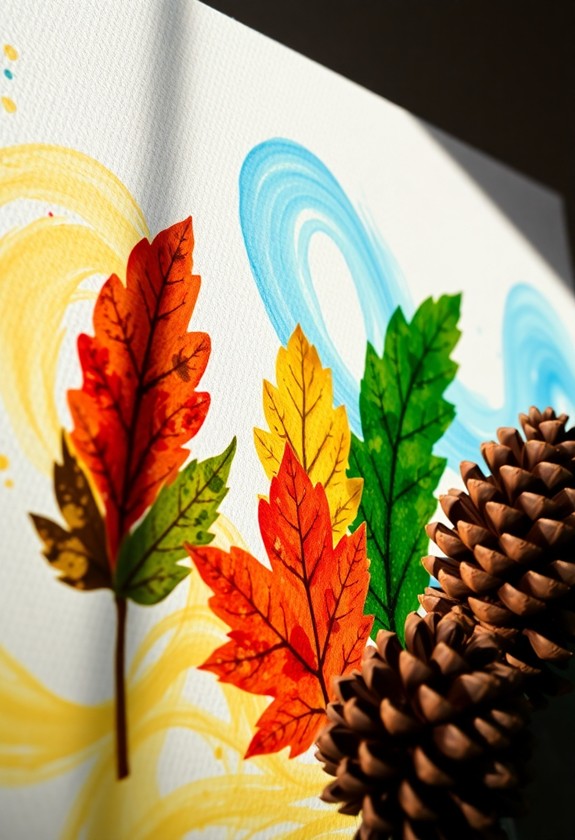Uncover nature's palette with these 10 eco-friendly toddler art projects! Let your little one's creativity blossom through leaf printing, mud painting, and flower petal collages. Watch their imagination soar with stick figure drawings and sand art sensory bins. Encourage exploration with pinecone painting and rock stacking adventures. Create unique masterpieces using grass brushes and natural clay sculptures. These hands-on activities not only nurture creativity but as well teach environmental awareness. From textural rubbings to colorful collages, each project promises messy fun and sensory delight. Get ready to release your toddler's inner artist during nurturing a love for nature. Excited to immerse yourself in a world of green creativity?
Creative Highlights
- Leaf printing with non-toxic paint teaches shapes, colors, and textures while promoting fine motor skills.
- Mud painting allows for messy exploration of textures and colors using natural items as paintbrushes.
- Flower petal collages encourage sensory investigation and creativity while developing fine motor skills.
- Pinecone painting incorporates nature's wonders to create unique patterns and textures on paper.
- Stick figure drawing with twigs promotes creativity and introduces nature as an eco-friendly art supply.
Leaf Printing

During the exploration of nature with your toddler, collect a variety of fallen leaves to create beautiful leaf prints. It's a fun, eco-friendly way to capture nature's beauty! This activity promotes skill development through art, enhancing hand-eye coordination and fine motor skills.
Here's how to do it:
- Gather your supplies:
- Leaves of different shapes and sizes
- Non-toxic, washable paint
- Paper
- Paint brushes
Experiment with different colors and leaf combinations. You can even create a leaf-print garden or forest scene! This activity not only sparks creativity but likewise teaches your little one about shapes, colors, and textures found in nature. Plus, it's a great way to "branch out" into the world of art!
Mud Painting
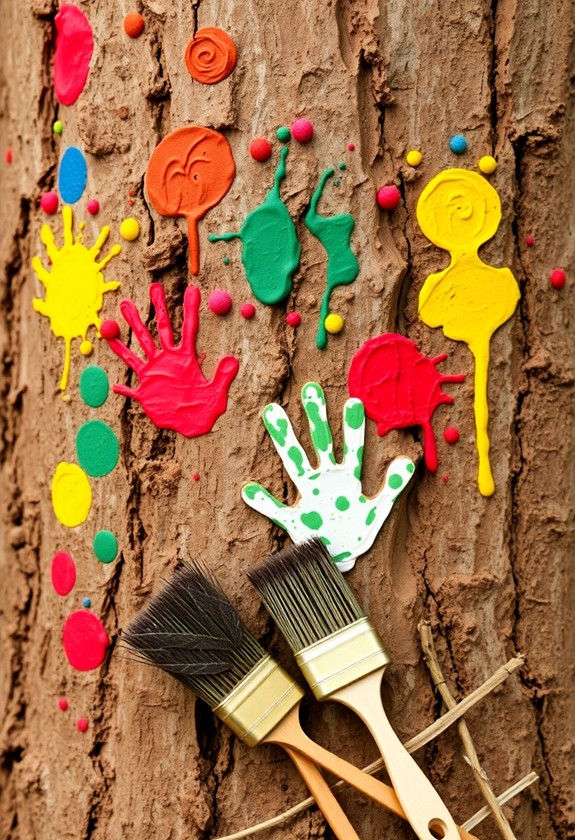
With mud painting, you'll tap into your toddler's natural love for messy play during creating eco-friendly art. It's a fantastic way to delve into texture and color during connecting with nature! This activity aligns with the multi-sensory experiences that aid in memory retention and information processing, essential for early childhood development.
Here's how to get started:
- Find a muddy spot or mix dirt and water
- Gather natural "paintbrushes" like sticks, leaves, and rocks
- Set up a large piece of paper or cardboard outside
Let your little one go wild! They can:
- Splatter mud with their hands
- Draw with sticks
- Make leaf prints in the mud
The possibilities are endless, and clean-up is a breeze – just hose everything down! But wait, there's more! As the mud dries, it creates amazing textures. Your toddler's masterpiece will be a one-of-a-kind, earth-toned wonder. Who knew dirt could be so delightful?
Flower Petal Collage
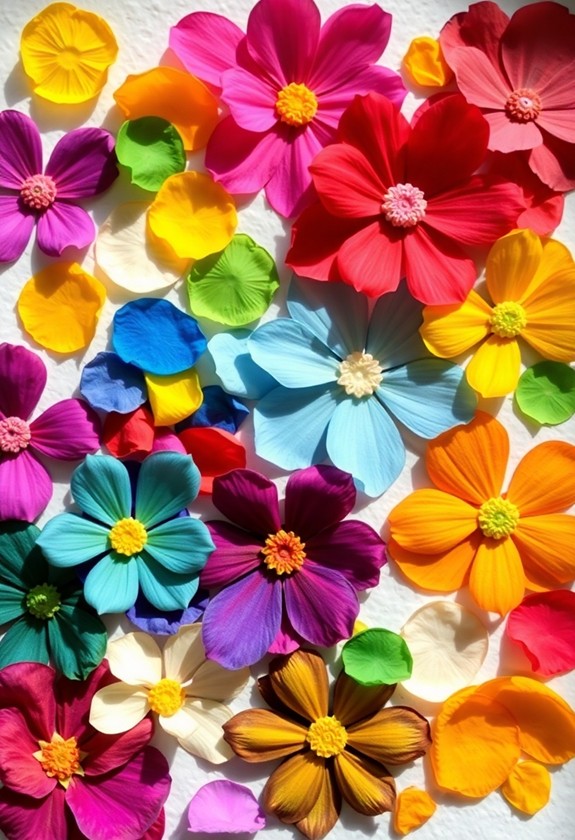
From mud to petals, we now turn to a colorful and fragrant eco-friendly art project. Flower petal collages are a fantastic way to engage your toddler's senses and creativity! You'll love watching their little faces light up as they investigate nature's lively palette. This activity not only promotes fine motor skills but also encourages sensory investigation, making it an ideal craft for toddlers of various ages and abilities.
To get started, head outside for a petal-picking adventure! Here's what you'll need:
- A variety of flower petals (different colors and sizes)
- A piece of sturdy paper or cardboard
- Non-toxic glue or a homemade paste
- A flat surface to work on
Encourage your little one to arrange the petals in any pattern they like. They can create a rainbow, a garden scene, or even a petal portrait! As they work, chat about the colors, shapes, and scents. It's a blooming good time that'll have your toddler's imagination in full flower!
Stick Figure Drawing
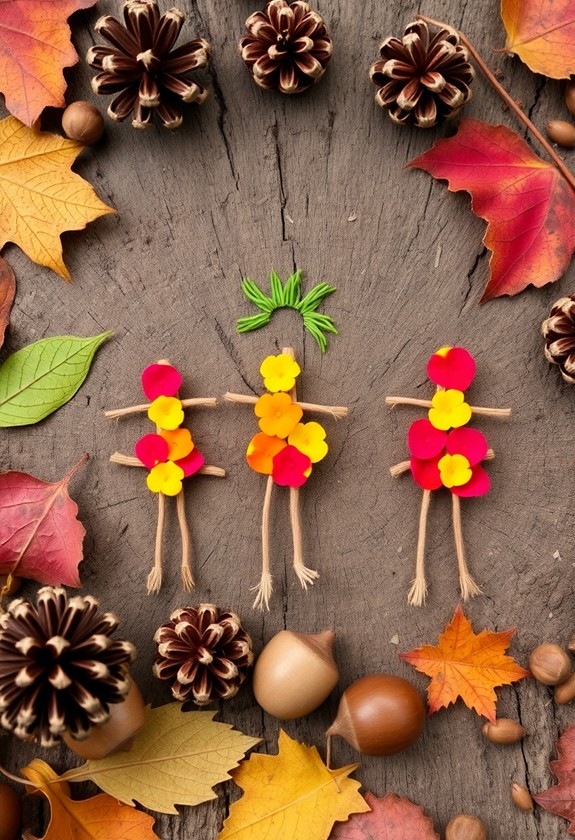
Let's move from petals to twigs! It's time to create adorable stick figure art with your little one. This project is a hoot and a half! You'll need:
- Twigs of various sizes
- A sheet of recycled paper
- Non-toxic glue
Here's how to do it:
- Head outside for a twig-hunting adventure!
- Arrange the twigs on paper to form a stick figure.
- Get creative! Add leafy hair or acorn buttons.
- Once you're happy with the design, glue it down.
Your toddler will have a blast making their very own twig person. And the best part? It's eco-friendly and teaches them about nature's art supplies. This activity is perfect for those days when you need indoor crafts to keep your little one entertained and engaged. Who knew sticks could be so much fun? This activity is certain to branch out your child's imagination!
Sand Art Sensory Bin
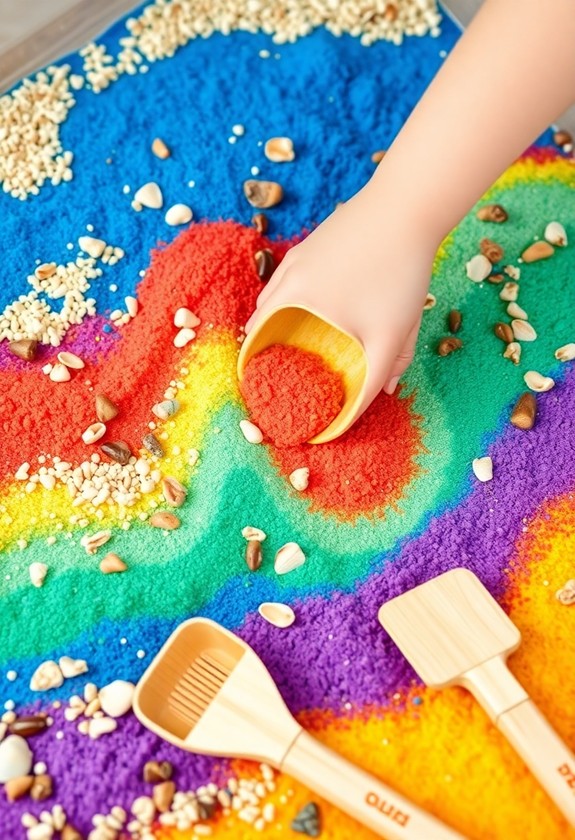
Ready to plunge into a world of tactile exploration? Sand art sensory bins are a fantastic way to engage your toddler's senses as creating eco-friendly masterpieces! You'll love watching your little one's imagination soar as they dig, pour, and sculpt their way through this sandy adventure. This activity aligns with the trend of eco-friendly materials in toddler crafts, promoting sustainability and sensory development. It's likewise an excellent way to incorporate cognitive development through creative play.
Here's what you'll need to get started:
- A shallow container or bin
- Natural sand (beach sand works great!)
- Eco-friendly food coloring or natural dyes
- Small toys or objects for added fun
Mix different colored sands to create a rainbow of options. Let your toddler scoop, pour, and mold the sand into unique shapes and patterns. They'll be having a blast as developing fine motor skills and sensory awareness. And the best part? It's all natural and easy to clean up. Get ready for some sandy, hands-on fun!
Nature Texture Rubbings
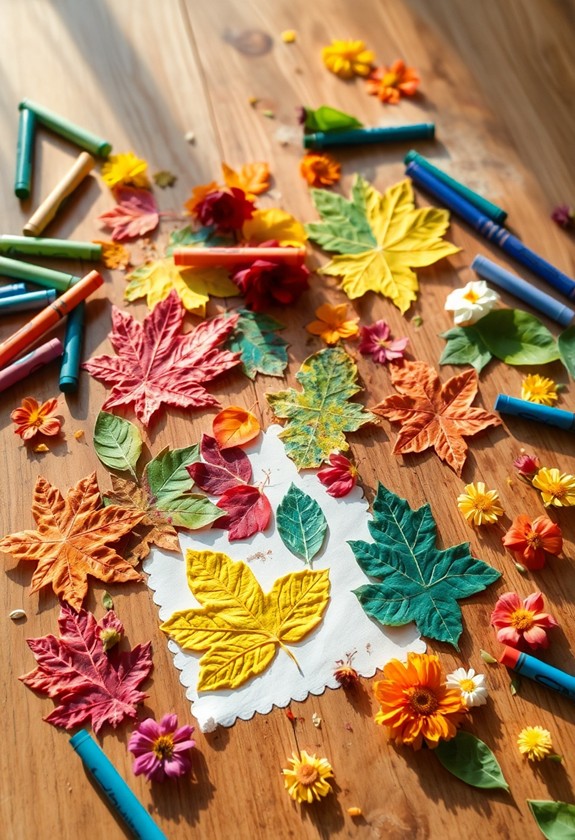
After examining the sandy world, it's time to venture outdoors and uncover the textures nature has to offer. Nature texture rubbings are a fantastic way to investigate the great outdoors and create beautiful art! Here's how to do it:
- Gather supplies: paper, crayons (with wrappers removed), and a clipboard
- Head outside and hunt for interesting textures
- Place your paper over the textured surface
- Rub the crayon sideways across the paper
Watch as hidden patterns emerge! Try tree bark, leaves, rocks, and more. Mix and match colors for a rainbow of rubbings. It's like nature's own coloring book!
This activity is not just fun but also helps develop fine motor skills and sensory awareness. Plus, it's a great way to teach your little one about different textures in nature. So, get ready to rub-a-dub-dub with nature's textures!
Pinecone Painting

Pinecones transform into nature's paintbrushes in this delightful eco-friendly art project. You'll love watching your little one's eyes light up as they dip and swirl these natural treasures! It's a fun, messy adventure that'll have you both giggling with joy.
Ready to plunge into this? Here's what you'll need:
- Pinecones (various sizes)
- Non-toxic, washable paint
- Large paper or cardboard
- Shallow trays for paint
Simply pour paint into trays, hand your toddler a pinecone, and let the magic begin! They'll be amazed as they roll, stamp, and drag the pinecones across the paper. Watch as unique patterns emerge – it's like a forest floor coming to life! And the best part? You're creating memories as you teach your little one about nature's wonders. So grab those pinecones and get painting!
Rock Stacking
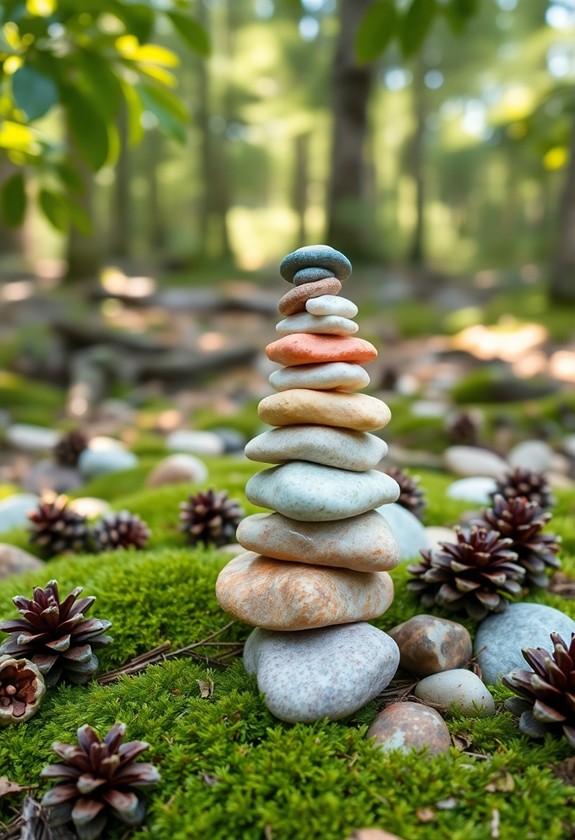
Rocks become nature's building blocks in this simple yet engaging activity. It's time to get stacking! Head outside with your little one and hunt for rocks of various sizes and shapes. The more diverse, the better!
Once you've gathered your rocky collection, find a flat surface to start your tower. Challenge your toddler to stack the rocks as high as they can. Watch their eyes light up as the tower grows taller!
Here's why rock stacking rocks:
- Develops fine motor skills
- Improves problem-solving abilities
- Boosts creativity and spatial awareness
- Teaches patience and persistence
Safety first! Make certain to supervise your little architect and choose a safe stacking spot. Remember, it's not about building the tallest tower—it's about having fun and connecting with nature. So, get ready to rock and roll with this stone-cold awesome activity!
Grass Brushes
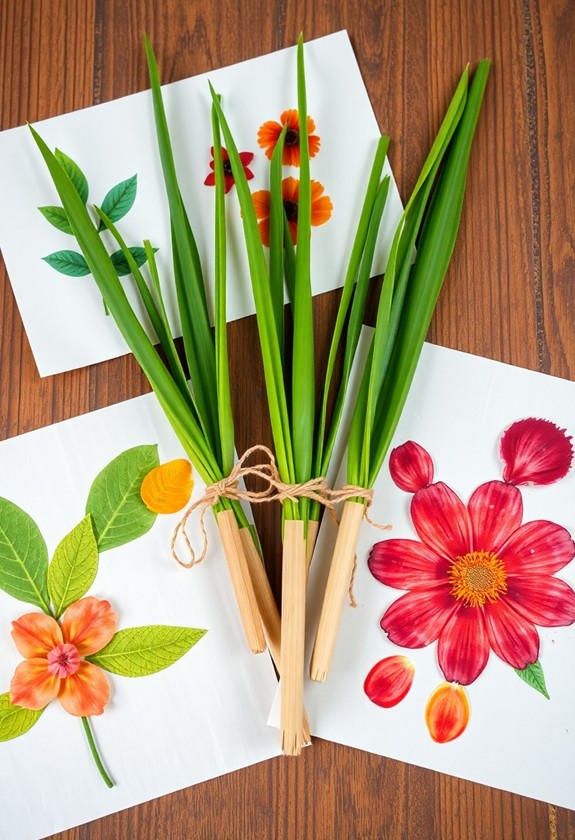
From stacking stones to painting with nature, let's explore another creative eco-friendly activity. Grass brushes are a fun, simple way to introduce your toddler to art using materials from your own backyard! Grab some grass, twigs, and rubber bands, and you're ready to go. These natural paintbrushes offer unique textures and patterns that'll spark your little one's imagination!
Here's how to make and use grass brushes:
- Gather a handful of long grass blades
- Secure them tightly to a twig using a rubber band
- Dip the grass end into eco-friendly paint
- Let your toddler swish, dab, and drag the brush across paper
Watch as your child creates masterpieces with swirly, streaky strokes! They'll love the tactile experience and the magical results. Plus, you're teaching them about nature's art supplies. It's a win-win for creativity and the environment!
Natural Clay Sculptures
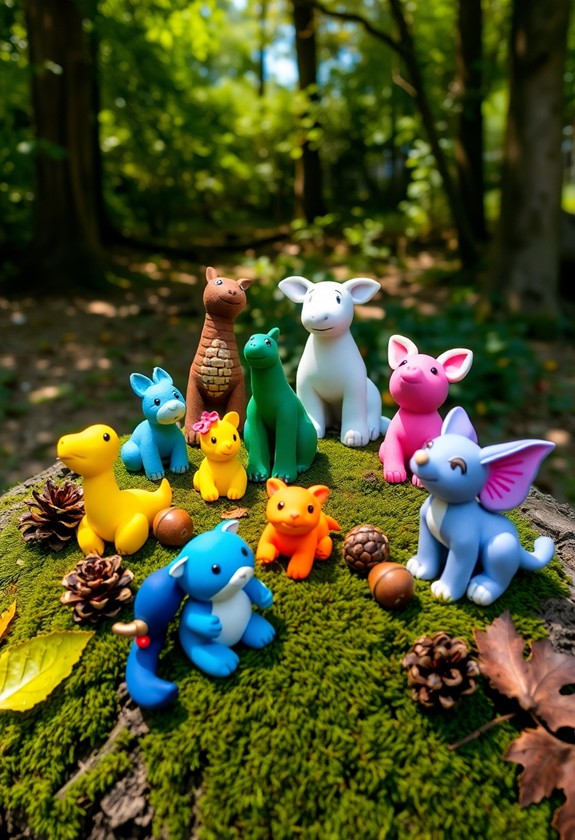
Along with grass brushes, natural clay sculptures offer another exciting eco-friendly art project for toddlers. You'll love this hands-on activity that connects kids with nature! Here's how to get started:
- Gather natural clay from your backyard or a nearby stream
- Clean the clay and remove any debris
- Knead it until it's soft and pliable
Now, let your little ones release their creativity! They can shape animals, make funky faces, or craft miniature environments. The possibilities are endless!
For added fun, incorporate:
- Pebbles for eyes
- Twigs for arms
- Leaves for hair
When the sculptures are complete, let them air dry. Voila! You've got a natural masterpiece that's kind to the environment. Plus, it's a great way to teach kids about sustainability as they're having a blast!
Curious Little Questions
How Can I Safely Preserve Nature-Based Art Projects for Long-Term Display?
Want to preserve nature's art forever? Well, you can't! But don't worry, you can come pretty close! Here are some fun ways to keep your leafy masterpieces looking fresh:
- Press flowers and leaves between heavy books
- Spray with a clear sealant (outdoors, please!)
- Dip in melted beeswax for a natural shine
- Frame under UV-protective glass
Are There Any Poisonous Plants to Avoid When Collecting Materials?
Yes, you definitely need to watch out for poisonous plants! It's super important to stay safe during fun times. Here are some biggies to avoid:
- Poison ivy – leaves of three, let it be!
- Poison oak – similar to ivy, but oak-shaped leaves
- Poison sumac – red stems with pointy leaves
- Foxglove – pretty but dangerous flowers
- Deadly nightshade – dark berries, yikes!
Always check with an adult or plant guide if you're not certain. Better safe than sorry regarding nature's tricky treasures!
What Age Group Are These Eco-Friendly Art Projects Most Suitable For?
Did you know that 90% of children's brain development happens before age 5? That's why these eco-friendly art projects are perfect for toddlers and preschoolers! You'll find they're most suitable for kids aged 2-5. At this age, little ones are bursting with curiosity and creativity. They'll love discovering nature's palette! Plus, these projects are safe, fun, and help develop fine motor skills. So grab your tiny Picasso and get ready for some natural masterpieces!
How Do I Explain the Importance of Eco-Friendly Art to Young Children?
You can make eco-friendly art fun and meaningful for kids! Start by explaining how it helps our planet. Say, "We're using nature's treasures to make art, and that's great for Earth!" Show them how cool it is to use leaves, twigs, and flowers instead of plastic. Get them excited about recycling old stuff into new creations. Make it a game to find natural materials. Remember, when you're enthusiastic, they'll catch on too! Let's create and care for our world together!
Can These Projects Be Adapted for Indoor Use During Inclement Weather?
Your indoor creativity can bloom like a flower in spring! You don't need to let rainy days dampen your eco-art spirit. Here's how to bring nature inside:
- Collect leaves, twigs, and flowers on sunny days
- Press and dry them for future use
- Use natural dyes from fruits and veggies
- Create nature collages on recycled paper
- Make leaf rubbings with crayons


